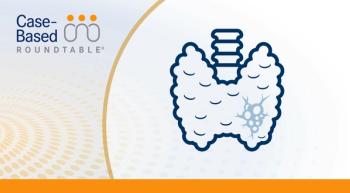
Future Considerations in the Management of Differentiated Thyroid Cancer
Lori Wirth, MD, discusses unmet needs and future considerations in the management of differentiated thyroid cancer.
Episodes in this series

Lori Wirth, MD: In terms of the future directions in DTC [differentiated thyroid cancer], there are several things to think about, 1 of which is planned drug holidays. There was an abstract presented at ASCO [American Society of Clinical Oncology Annual Meeting] this year by Makoto Tahara and colleagues from Japan that took a look on real-world patient population in Japan and how patients did when treated for iodine-refractory DTC with lenvatinib when they had a planned drug holiday baked into the treatment plan vs those patients that did not have a planned drug holiday. I was surprised to see that, in those patients who had the planned drug holiday, it looked like they may be doing a little better. That needs to be put to the test in a clinical trial, but those real-world data are very interesting.
Another important emerging question in the field is how to best sequence therapy. For example, we now know that a large percentage of patients with DTC will have common targetable molecular alterations such as RET fusions and NTRK fusions. There are gene-specific therapies that are highly active in those patients, but patients also can respond quite well to the MKIs [multikinase inhibitors] such as lenvatinib or even sorafenib. What’s the best sequence? Should you use a gene-specific therapy first and then, if you do, will you still be able to see activity with a multikinase inhibitor? We don’t know the answer to that question, but that certainly deserves further study.
Another intriguing question that’s very difficult to answer is the idea of the VEGFR multikinase inhibitors as drugs that can modulate the tumor microenvironment and predispose patients to respond better to immune checkpoint inhibitors. We’ve seen in a number of solid tumor types that the combination of lenvatinib and pembrolizumab can have better activity than you’d expect with either drug alone; we’d love to know if that’s true in iodine-refractory DTC.
There was a small study that was done by the International Thyroid Oncology Group that unfortunately was a single-arm trial looking at the combination of lenvatinib and pembrolizumab. Without a comparison and without a much larger study, it’s impossible to know if in first-line therapy lenvatinib and pembrolizumab may be better than lenvatinib alone. However, there was a second cohort to that trial that added pembrolizumab in as salvage therapy when patients progressed on lenvatinib. Those data had been presented at ESMO [European Society for Medical Oncology Congress] last year and showed that you can salvage a number of patients by the addition of pembrolizumab to lenvatinib at the time of progression; that strategy really deserves further study.
One other thing I would say about the information that we don’t know for our patients with thyroid cancer is what the mechanisms of resistance are, particularly to these multikinase inhibitors. If we could figure out why patients can have such beautiful responses but then eventually progress, we would know how to design the next generation of drugs to overcome that acquired resistance. That still is something that’s relatively under studied in the field.
My practical advice for a community oncologist treating DTC, because it is such a rare disease, is to phone a friend. People who work in academic medical centers love to be able to help the patients who are out there as much as possible and are always happy to field questions. The other thing I would say is that the American Thyroid Association guidelines for thyroid cancer are very helpful. There are guidelines for anaplastic thyroid cancer that just came out. There are guidelines that are older for medullary thyroid cancer and also differentiated thyroid cancer. They’re going to be updated, and they’re very detailed, with a wealth of information for medical oncologists.
One last thing I would say is that I do think that tumor genotyping for these patients is very important. We do find frequent actionable gene alterations in patients with iodine-refractory DTC. The most common mutation is BRAF V600E. BRAF-directed therapy has not become first-line therapy for these patients, but it might be a reasonable second- or third-line option for patients. We also know that patients with DTC can harbor RET fusions, NTRK fusions, ALK fusions, and ROS1 fusions. When thinking about initial therapy for patients, there’s a role for genotyping. You want to make sure that the assay you’re using is an assay that’s very good at picking up the multitude of gene fusions we see in thyroid cancer, not just the primary fusion partner—RET, NTRK, etc—but also all the number of 5’ fusion partners that RET, ALK, NTRK can be rearranged with.
Transcript edited for clarity.











































